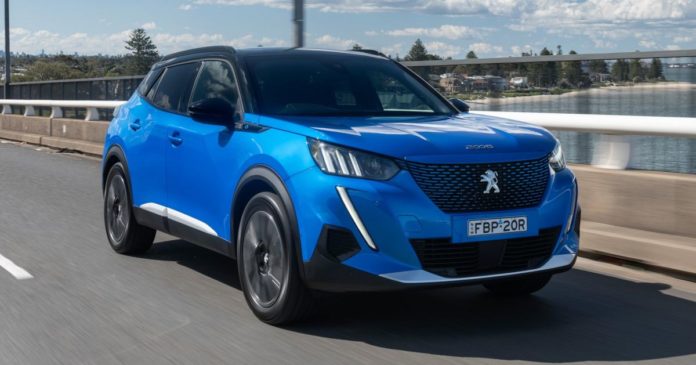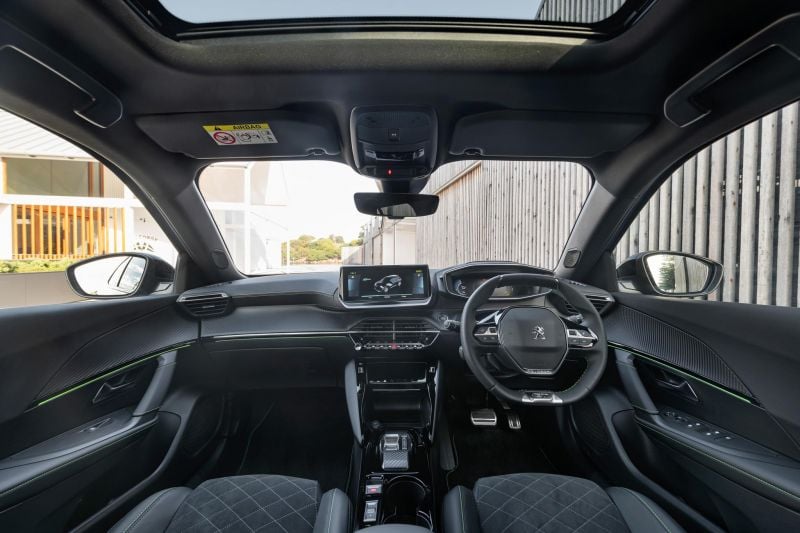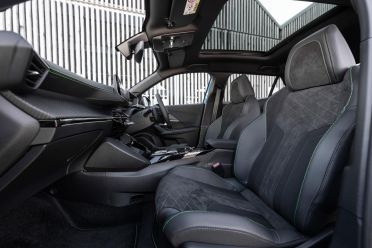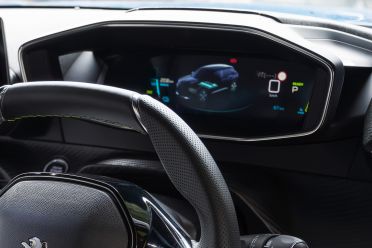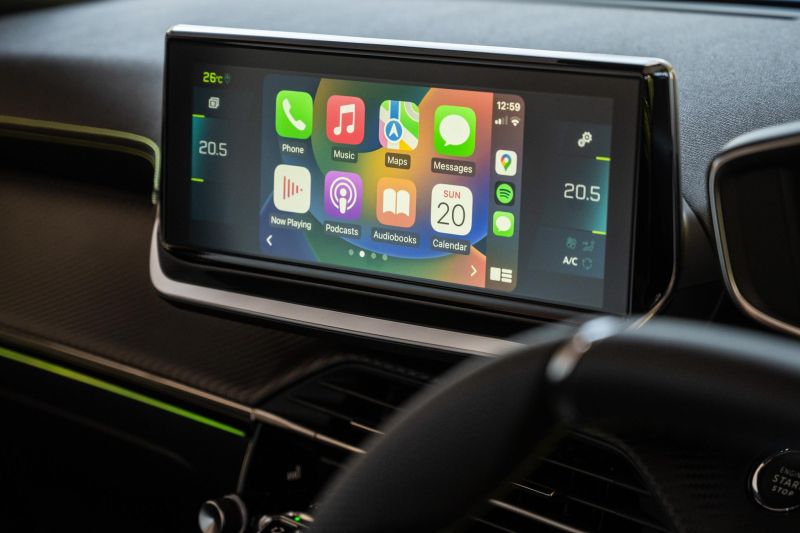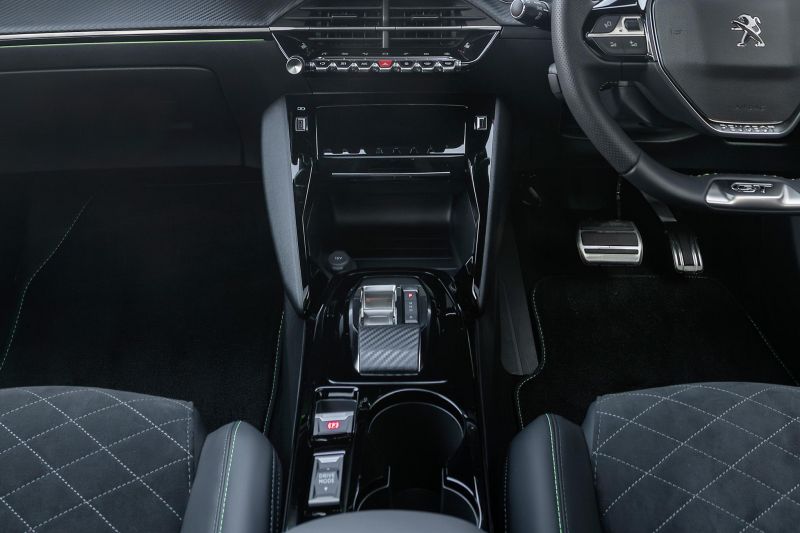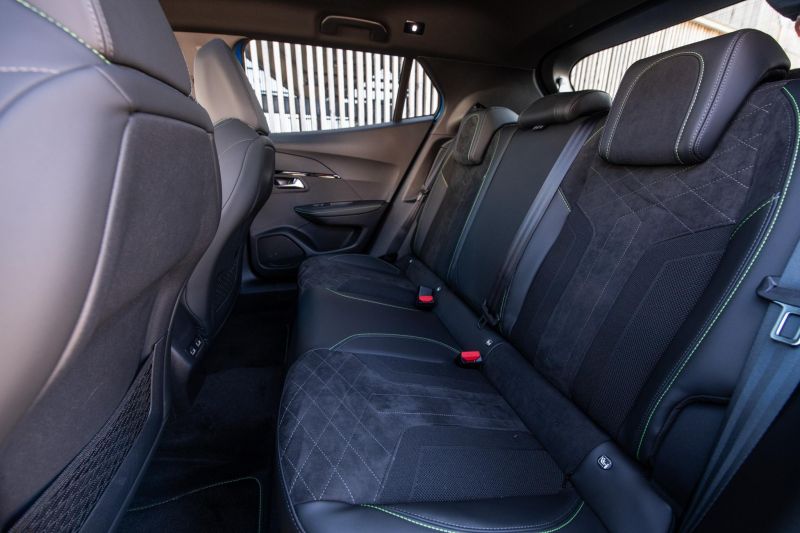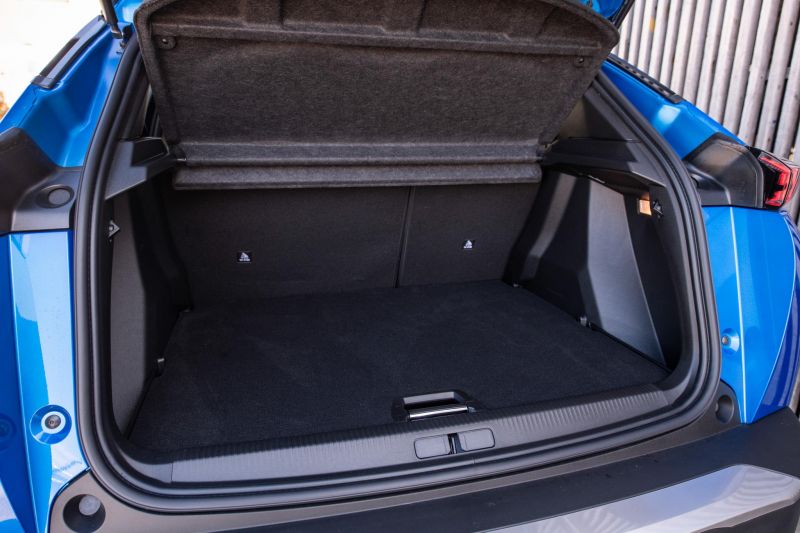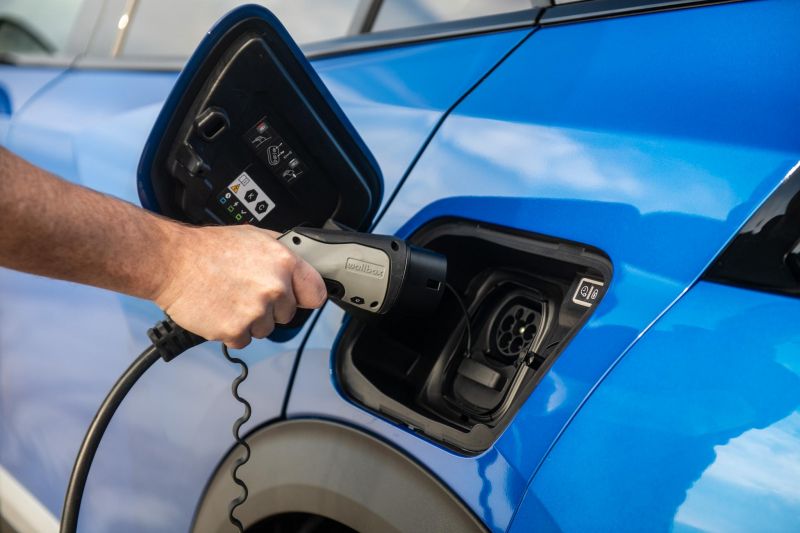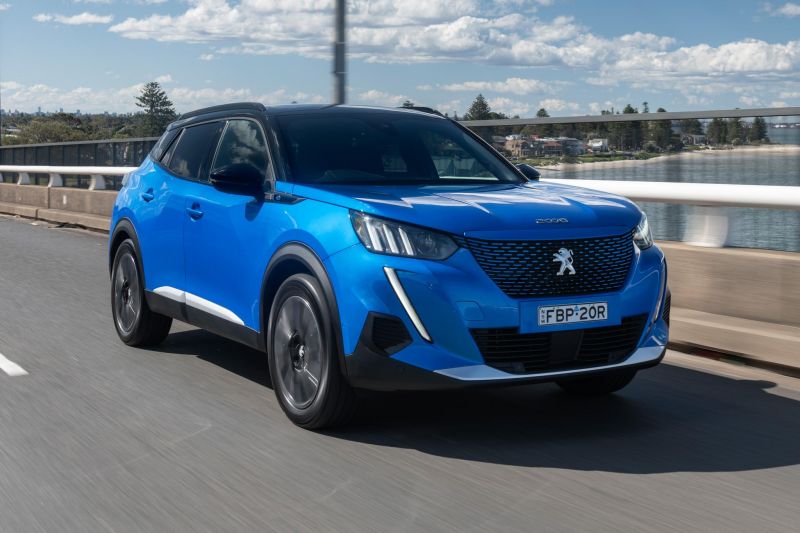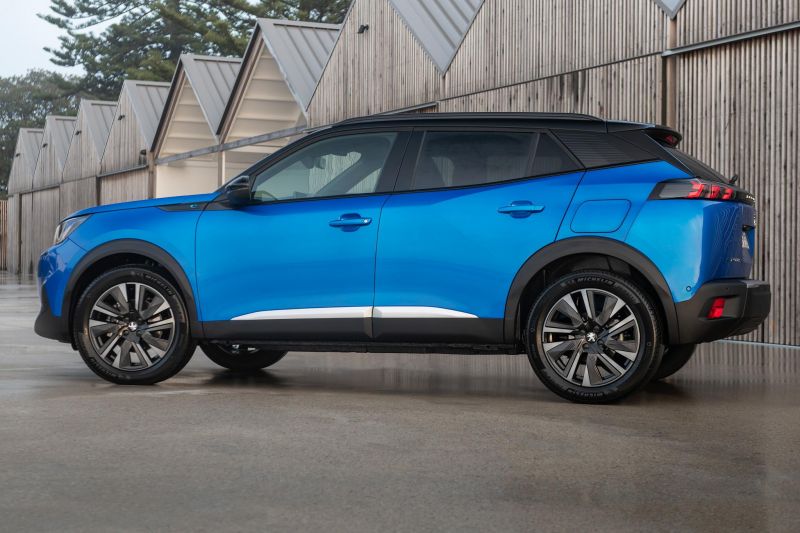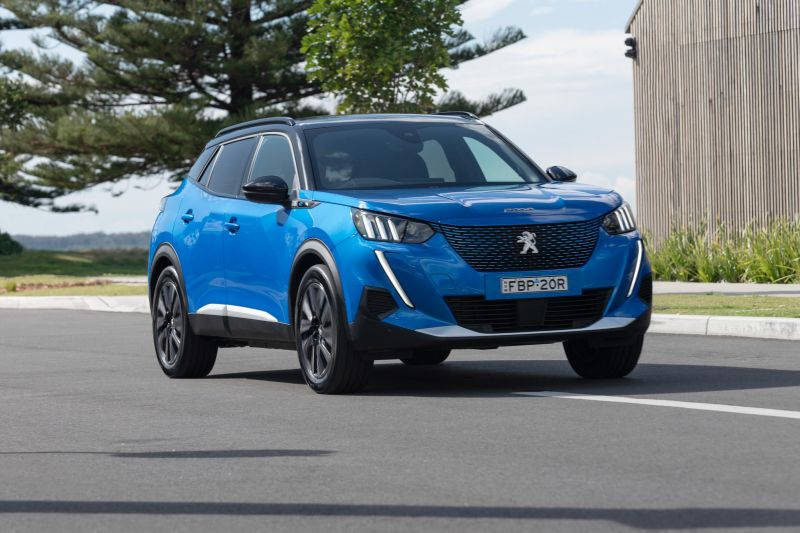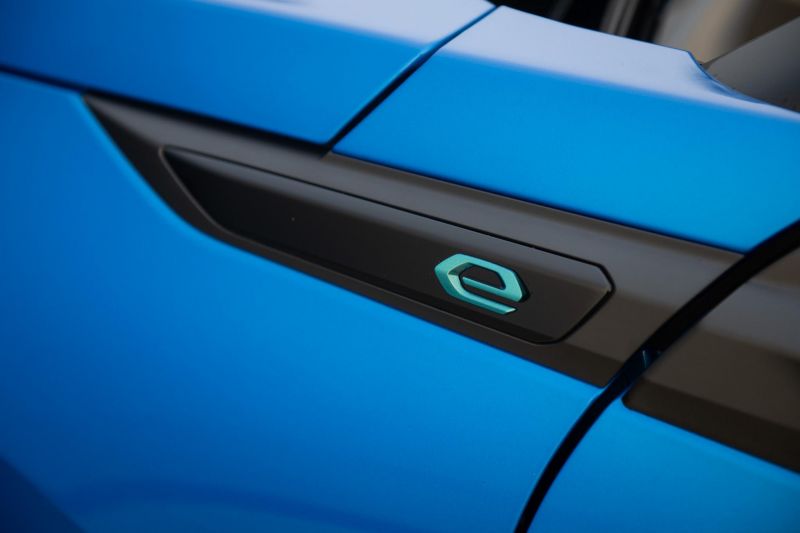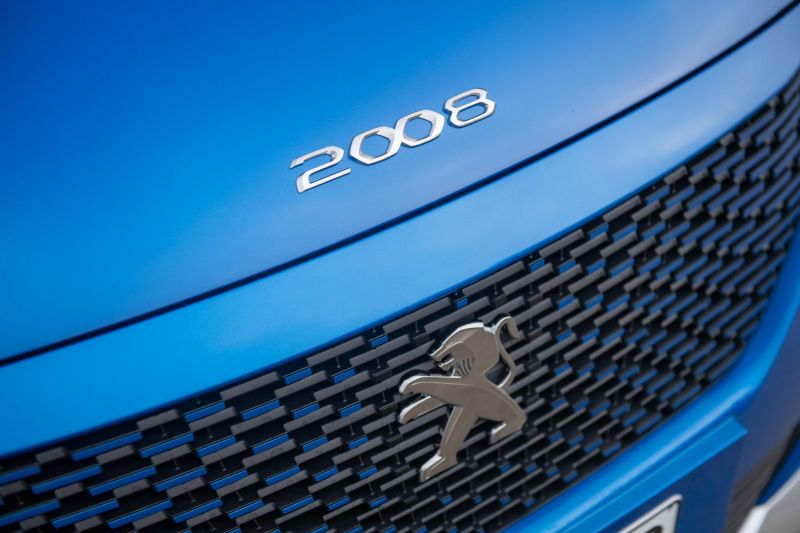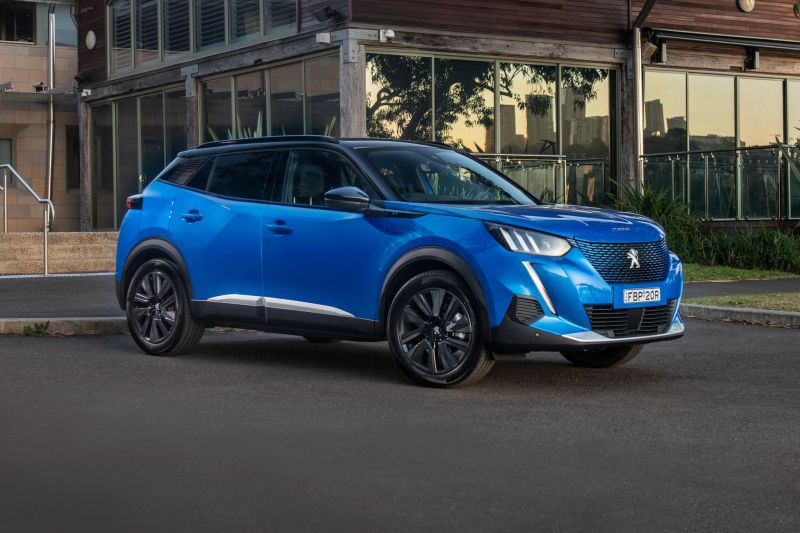The all-electric Peugeot e-2008 has just splashed onto the Australian new car market, around three years after the combustion-powered 2008 arrived in local showrooms.
Controversially the e-2008 has come to Australia in pre-update form. Peugeot recently revealed the mid-life update for the SUV line-up which brought new looks inside and out, as well as more power and range for the e-2008. This model is set to arrive locally at an unconfirmed date.
For now, Peugeot Australia is only being offering in a single highly-specified GT trim at launch, which is priced from $59,990 before on-road costs. At this stage the company doesn’t plan to introduce a lower-specification e-2008 variant any time soon.
The e-2008 electric SUV is the second electric vehicle (EV) Peugeot Australia has introduced locally, following the e-Partner commercial van which has the exact same electric motor and battery setup. At roughly $60,000, would you consider this quirky French small electric SUV?
How much does the Peugeot e-2008 cost?
The Peugeot e-2008 at launch is only available in high-spec GT specification, which costs $59,990 before on-road costs. In Victoria the electric SUV is $65,455 drive-away (each state has different taxes).
The e-2008 GT is $16,593 more expensive than its combustion-powered 2008 GT equivalent, which is quite a significant jump. There are no option packages available in the e-2008 GT, with the only additional cost being metallic (+$690) or premium (+$1050) paints.
In terms of similarly priced rivals there are more and more arriving on Australian shores each month. Some notable examples include the Cupra Born ($59,990), Hyundai Kona Electric Elite ($60,500), Kia Niro EV S ($66,590), as well as the forthcoming Volvo EX30 ($59,990).
The Peugeot e-2008 GT’s pricing is just a stone’s throw away from the likes of the larger and top-selling Tesla Model Y ($65,400). It’s also notably more expensive than other Chinese-built electric SUVs like the BYD Atto 3 Extended Range ($51,011) and MG ZS EV Long Range ($55,990).
What is the Peugeot e-2008 like on the inside?
Hopping in the all-electric Peugeot e-2008 feels very similar to the combustion-powered 2008 at first. The two have a similar hip height which means ingress and egress is easy.
The e-2008 is only coming as a singular GT specification at launch, meaning the majority of the interior trimmings mirror what’s standard in the 2008 GT.
The seats in the e-2008 GT are finished in a combination of leather and Alcantara with green contrast stitching, which looks and feel quite luxurious. The driver’s seat is electrically adjustable, including electric lumbar, and also has a massage function which is a little special.
When I sat in the driver’s seat it felt really supportive with plenty of side bolstering hugging me in, although I couldn’t escape the feeling the knees were up quite high. I’m unsure if this was due to the positioning of the high-voltage battery, as when I felt further back under the seat with my feet there was a really pronounced rise for the battery pack.
Ahead of the driver is a two-spoke leather-wrapped steering wheel which is small and compact. It’s a little cute actually, with its pronounced ‘GT’ badge, and it feels thick in hand.
The steering wheel only has a few buttons on it and two scroll wheels. The latter are a little confusing at first because they’re not clearly labelled, so it’s a bit of trial and error to figure out what they actually do. For those who are curious, the left-hand one alters the digital instrument cluster and other skips the audio track.
There’s also a knobbly cruise control stalk hidden behind the steering wheel that you won’t notice is there unless you were actually looking for it, or already knew it was there. If you’re planning to use cruise control I recommend looking at how this stalk works before setting off.
Something that took me a while to get used to is how the steering wheel needs to be positioned in relation to the digital instrument cluster. I needed to have the steering wheel out as far as it can go and almost in my lap in order to see the screen.
I already know this setup of looking over the steering wheel into the digital instrument cluster is controversial and not everyone’s cup of tea, but over the space of 30 minutes or so I got used to it. I also wasn’t compromised and could steer the car properly.
The 10-inch digital instrument cluster has a 3D function that’s super interesting to look at, especially from the passenger’s side as it’s more pronounced. I imagine for some drivers this could be a little disorienting and they would be looking to switch it off.
There are a number of different informative content pages on the digital instrument cluster that can be scrolled through. The range, current speed, and throttle application, among others, however, are also on show.
Moving across the standard 10.0-inch touchscreen infotainment system is mounted high like the digital instrument cluster, and tilted toward the driver.
During my time over the e-2008’s local media launch I found the touchscreen was responsive enough, although it could be caught napping. This means it could use perhaps a bit more processing power in order to make the system feel a bit snappier.
The infotainment system comes standard with a satellite navigation system that worked well enough, though at points it was a touch laggy or grainy.
There is also Apple CarPlay and Android Auto, although they are only available in their wired forms which means you’ll need bring a USB cable with you. The smartphone mirroring window doesn’t take up the full screen as the climate control sections flank each side.
Speaking of climate control, the only way you can adjust these settings is through the touchscreen. There are some piano-key buttons for certain functions, but if you want to change the temperature or where the air is blowing, you’ll be using the screen. This can a little frustrating on the move as it’s easy to miss the spot you’re meant to click.
Around the cabin there are some soft plastics, although you don’t need to look far to find a wider range of harder plastics. There’s also a fair use of shiny piano black on the centre tunnel which I can guarantee won’t take long to get grimy and scratched.
Unlike the combustion 2008 models, the e-2008 has a small toggle switch for the gear selector. It’s very similar to the one in the latest 308.
I found the e-2008’s drive mode selector is a little too far back, meaning I need to bend my arm a little like a T-Rex in order to operate it.
Moving to the second row there’s an obvious step down in amenities. The seats still look and feel great, but you do feel a little like a second-class citizen. There’s enough head, shoulder, knee and top space in the second row, though like the first row I felt my legs were up a bit high.
In terms of second-row amenities there are two USB-A ports. That’s it. There are no rear air vents, nor a fold-down armrest with cupholders…
The e-2008 comes with a manual tailgate, which is a little disappointing given its asking price. There is 434 litres of boot capacity on offer, which is the exact same amount as the combustion-powered 2008 models.
The boot floor has two positions, which in its highest position creates a small underfloor section that can be used to store the charging cables in.
There’s no spare tyre, which is unfortunately common in EVs. Instead there’s a tyre repair kit which isn’t ideal because this won’t fix every issue.
What’s under the bonnet?
The Peugeot e-2008 GT is powered by a single, front-mounted electric motor producing 100kW of power and 260Nm of torque. This is fed by a 50kWh lithium-ion battery pack.
Peugeot claims the e-2008 GT can do the 0-100km/h sprint in 9.0 seconds, which is 0.3 seconds quicker than the combustion-powered 2008. Flat out you’ll be doing 150km/h.
The e-2008 has a claimed WLTP range of up to 328km, which is notably lower than a number of similarly priced EVs. It has a maximum AC charging rate of 11kW and a maximum DC rate of 100kW. Charging with the former from 0-100 per cent takes approximately five hours, whereas charging with the latter from 0-80 per cent takes 30 minutes.
Over the local media launch drive of the e-2008 GT which covered around 100km of mainly urban and metropolitan roads in Sydney’s north, the electric SUV had an average energy consumption of 16.3kWh per 100km. That’s not too bad at all!
How does the Peugeot e-2008 drive?
Starting up the Peugeot e-2008 is a silent affair. You do need to push the start button for an awkward amount of time for it to register that it actually needs to switch on.
When you get moving there’s a low-speed whir that can only be heard on the outside. This is so pedestrians and other vulnerable road users can hear when you’re approaching because the car itself is so quiet.
The e-2008’s single electric motor has enough power to get you moving with the traffic, although you won’t get your socks blown off.
If you floor it you’ll pull ahead of traffic from the lights and feel a slight push into the seat. EVs have an inherit surge of torque at low speeds because it’s all available from a standstill. You’ll quickly reach the limits of the 100kW electric motor though.
Beyond the ‘Normal’ drive mode, the e-2008 comes with an ‘Eco’ and a ‘Sport’ mode. The former significantly reduces the power output unless you absolutely floor it, whereas the latter makes the car feel a bit quicker though you won’t be spinning wheels at any point.
The Peugeot e-2008 feels most at home in city or urban environments, which is arguably where the majority of buyers will spend the most of their time.
Given the e-2008’s steering wheel is on the smaller side, it already feels a bit like a go kart. This feeling is amplified with the lighter steering feel.
Although the e-2008 is around 300kg heavier than the combustion-powered 2008 you rarely feels this added weight in regular driving. Around certain corners if you carry speed you’ll feel it but it’s not overwhelming. The car also never understeers.
The e-2008 has the same suspension hardware as the combustion-powered 2008, although there are slightly different spring and damper tunes to compensate for the added weight.
Over pimply urban and metropolitan roads the e-2008 feels really comfortable and never gets unsettled. It also takes all kinds of speed bumps in its stride.
One minor disappointment with the e-2008 is it doesn’t come with a proper one-pedal driving function. Instead there’s a ‘D’ and ‘B’ mode that both require the use of the brake pedal in order to come to a complete stop.
Like the Cupra Born, the most natural mode was the more powerful ‘B’ driving mode because driving an EV with minimal regenerative braking feels a little strange. In saying that, the brake pedal seemingly has regenerative braking built into it and the transition to regular friction braking can be awkward and disjointed at times. This is common trait among a number of hybrids and EVs.
Building up the speed it’s apparent just how quiet the e-2008 is. Peugeot seems to have done a great job in insulating and reducing the amount of road noise that enters the electric SUV, even at higher speeds.
It’s evident when driving on highways and freeways the e-2008 doesn’t have much else to give. It can maintain highway speeds really effortlessly, but you’d need to really think about whether you have enough space to do an overtake.
On the safety front, the Peugeot e-2008 GT is fully loaded. It comes with adaptive cruise control with stop and go, as well as a lane-centring function, among other features. Some notable absences though across the entire 2008 line-up is rear cross-traffic alert, as well as a proper surround-view camera.
What do you get?
Peugeot e-2008 GT highlights
Exterior
- 18-inch black diamond cut alloy wheels
- Tyre repair kit
- Body-colour chequered radiator grille
- Nera black side mirrors
- Heated, power-folding side mirrors
- Diamond black rear spoiler
- Diamond black contrasting roof
- Adaptive LED headlights
- Auto high-beam
- LED daytime running lights with integrated fog lights
- LED tail lights
- Door-mounted puddle lights
- Rain-sensing window wipers
- Privacy glass
- GT badging
- E badging
Interior
- 10.0-inch digital instrument cluster
- 10.0-inch touchscreen infotainment system
- Wired Apple CarPlay, Android Auto
- Satellite navigation
- DAB+ digital radio
- 6-speaker sound system
- Dual-zone climate control
- 8-colour ambient interior lighting
- Keyless entry and push-button start
- Electric park brake
- ‘e-Toggle’ gear selector
- Leather-wrapped steering wheel
- Illuminated vanity mirrors
- Frameless auto-dimming rear-view mirror
- Chrome-trimmed sport pedals
- Alcantara and leather-effect upholstery
- Heated front seats
- Electric driver’s seat adjustment
- Electric lumbar support
- Massage function
- Mode 3 charging cable
Is the Peugeot e-2008 safe?
The combustion-powered Peugeot 2008 has a five-star ANCAP safety rating, though for now the electric e-2008 counterpart remains unrated.
-

2008
Standard safety features include:
- Autonomous emergency braking (AEB)
- Low-light pedestrian detection
- Cyclist detection
- Blind-spot monitoring
- Lane departure warning
- Active Lane Following Assist
- Adaptive cruise control with stop and go
- Traffic sign recognition
This is in addition to front, side and curtain airbags.
How much does the Peugeot e-2008 cost to run?
The Peugeot e-2008 is covered by a five-year, unlimited-kilometre warranty. In addition, there’s also an eight-year, 160,000km warranty for the high-voltage battery.
Logbook servicing is required every 12 months or 25,000km, whichever comes first. The first five services are priced as follows:
| 12 months/25,000km | $258 |
|---|---|
| 24 months/50,000km | $360 |
| 36 months/75,000km | $258 |
| 48 months/100,000km | $374 |
| 60 months/125,000km | $272 |
| Total | $1522 |
Peugeot Australia also offers pre-paid servicing for the e-2008. A three-year package costs $600, whereas a five-year package costs $1000.
CarExpert’s Take on the Peugeot e-2008
The Peugeot e-2008 is a cute and quirky little package that forms as an appealing alternative to the growing number of Chinese-built EVs on the Australian new car market.
It offers a refined and quiet driving experience, with just enough power to keep you satisfied. The small electric SUV also comes just about fully loaded which leaves you not wanting for much.
Given its steep asking price, I’m afraid the e-2008 GT could unfortunately form as a niche of a niche. Only 174 combustion-powered Peugeot 2008 vehicles have been sold to the end of August in 2023.
At roughly $60,000 this French electric small SUV is just a stone’s throw away in terms of price from the larger and top-selling Tesla Model Y in terms of price. Thankfully it’s not as much as the Kia Niro EV, or more luxurious options like the BMW iX1, Lexus UX 300e, and Mercedes-Benz EQA.
Peugeot Australia claims it has “good” stock of the e-2008 for this year and will have enough supply to meet the demand. For now we’ll just have to wait and see what impact this small electric SUV actually has on the Australian new car market.
Click an image to view the full gallery
BUY: Peugeot 2008
MORE: Everything Peugeot 2008

